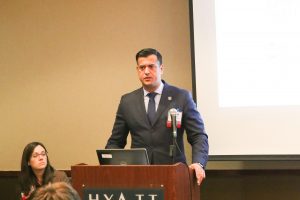Session Summary
New Jersey’s population is aging. As a significant portion of our population continues to approach age 65, how will this impact the needs of communities throughout New Jersey? A 2018 AARP survey shows that eight out of 10 adults age 50 and older want to stay where they live. Many people in New Jersey live in areas where they may have raised a family, have close ties to friends, neighbors, and medical professionals, feel a sense of social belonging, and have access to other essential resources. However, Emily Greenfield, associate professor at Rutgers University School of Social Work and moderator of the panel, explained that several communities throughout the state were developed with land-use patterns that do not support the needs of an aging population. How do we create communities that can, and how can we redevelop the built environment to create communities where people of all ages can thrive? First, we have to start with understanding what older populations value in the places they live.
For the most part, aging populations want to be in livable communities—walkable, transit-oriented, mixed-use neighborhoods that embody accessibility, convenience, and safety. AARP defines livable communities as having “affordable and appropriate housing, supportive community services, and adequate mobility options, which facilitate personal independence and the engagement of residents in civic and social life.” These characteristics are in line with what populations of all ages value in the places they want to live. As the New Jersey state director of AARP, Stephanie Hunsinger understands that “people want to live in a community that they can call home. Age doesn’t define what we look for in our communities.”
To design and plan for livable communities, Mayann Bucci-Carter discussed how form-based code, a regulation that values physical form over separation of uses for land development, complements redevelopment projects. A professional planner with CME Associates, Bucci-Carter explained that form-based code implementation planning starts with a vision to create livable communities that are better for people of all ages. This allows a town to then implement redevelopment projects that support and contribute to that goal, rather than planning based on the factors of an already car-dependent community and hoping the rest follows. This results in a built environment with a strong sense of place at the core, which is specifically designed to be useful for all ages, Bucci-Carter explained. She also emphasized that redevelopment, with a heavy emphasis on community outreach and participation, is key with these projects, as it may not always apply to traditional zoning.

Ridgewood Village Mayor Ramon Hache.
Mayor Ramon Hache of Ridgewood Village shared how his town wasn’t always known as one that was best suited for older populations. Mayor Hache is making it a priority to engage residents and create a community where everyone can create a community that everyone can remain living in throughout their lives; Ridgewood worked with New Jersey Future to complete a land use analysis for the town, where a steering committee is prioritizing the recommendations to develop an aging friendly implementation plan. For the first time in U.S. history, adults age 65 and older are projected to outnumber children under 18 around the year 2030. As this age demographic grows, the Ridgewood mayor understands that this valuable group can sometimes be overlooked, emphasizing, “we don’t want seniors to feel left behind.” By prioritizing creating a community where all its members can age in place and understanding the needs of those residents, a town can begin to implement redevelopment projects.
What do these projects look like? Metuchen Borough has gone through an almost 30-year redevelopment, leading it to be the vibrant downtown that it is today. A major focus of the Metuchen Downtown Alliance was to revitalize the downtown business district through strong partnerships with various local stakeholders and community members, said executive director Isaac Kremer. Kremer showed the audience photographs of the changes in Metuchen’s downtown that led to its reactivation: eye-catching storefronts and public art, attractive lights and signs, sidewalks with comfortable seating, and greenery that drew in residents and visitors to a walkable, active community. As evident in Metuchen, supporting populations of all ages by creating livable communities also has a great economic benefit. Property values increase as access to green spaces, walkability and compactness, housing diversity, and transportation options increase, Hunsinger explained. She also said that seniors’ spending patterns show that they contribute significantly to a local economy. Metuchen’s success stems from showing members of the community how their needs are valued by the way the environment is designed for everyone to use and appreciate.
Greenfield told the audience to center redevelopment projects around a vision of making communities better for all ages. Municipalities across New Jersey have started, or already have been, planning for people-focused, connected communities rather than car-dependent, inaccessible sprawl. By building communities where people can live, work, and play, we can build communities that people truly love. Designing communities for all ages isn’t only possible, it’s achievable. Where does your community stand?
This summary was written by Lauren Belsky from New Jersey Future.